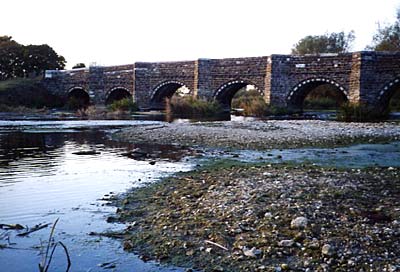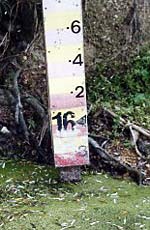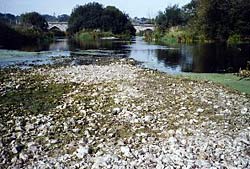| MARK WINTLE |
| Mark Wintle, an angler for thirty-five years, is on a quest to discover and bring to you the magic of fishing. Previously heavily involved with match fishing he now fishes for the sheer fun of it. With an open and enquiring mind, each week Mark will bring to you articles on fishing different rivers, different methods and what makes rivers, and occasionally stillwaters, tick. Add to this a mixed bag of articles on catching big fish, tackle design, angling politics and a few surprises. Are you stuck in a rut fishing the same swim every week? Do you dare to try something different and see a whole new world of angling open up? Yes? Then read Mark Wintle’s regular weekly column. |
DROUGHT
Drought is defined as dryness and lack of rain. It could be an accurate summary of summer and autumn 2003 in many parts of England. August and September have been collectively the driest since records began. Of course, the rains will set in with a vengeance the moment that official recognition is given to a drought or, in my case, I get around to writing about it. Dennis Howell, Minister for Drought in September 1976, had barely had the sign put on his door when the drought ended and the flooding started.
Before I write about this year, it’s worth remembering just how bad the drought was in 1976. The early seventies experienced a succession of dry years with 1973 and 1975 being especially dry. In between, 1974 was nearer the average. But not only was 1975 an exceptionally dry year, the drought continued through the winter, and consequently the heatwave and drought of 1976 meant that, in many cases, river levels were at their lowest for many years. Anglers and conservationists warned of an increasing risk of a parched landscape. At the time, an increasing demand for water led to more and more abstraction. The consequence was that some rivers dried up in their highest reaches. Such droughts have been recorded before in history, with the period before the Great Fire of London (1666) being chronically bad. After 1976, the rainfall returned to normal for the most part. Eventually, the Environment Agency took notice of the excessive abstraction, and began to rescind the abstraction licenses on the worst hit streams. New reservoirs were built and water metering introduced. Though the pressures on our water reserves have continued to climb, there is some evidence of better water management. Why does the fishing get so hard?
The fishes’ instincts are kicking in, and the first instinct is the avoidance of exposure to predators, especially those in the air. Furthermore, many fish have an inborn instinct to vacate shallow water when levels drop. This is a protection against getting stranded when floodwaters are dropping. So, don’t be surprised to find congregations of fish in deeper pools, especially those with some cover overhead. The second factor is that with much less current, any waterborne sediment will drop out, and be filtered out by weed, so that the water is likely to be much clearer than normal. This further increases the fishes’ wariness in that the fish are able to inspect your end rig, as well as see you coming. So the relatively thick line and big hook that fooled the fish back in June may need much refinement for you to stand a chance of a bite. The fish will spot you approaching more easily as well. By the time you are ready to cast the fish are already spooked. Yet another adverse effect of autumn drought is that the extensive weed growth of summer stopped growing in late summer. It then begins to rot. In a normal year we get enough mini floods to shift this rotting weed in a succession of flushes so that the build-up of muck is not too bad. But with no increase in the flow whatsoever, more and more rotting weed builds up added to by the falling leaves. The bacteria that break this down use up dissolved oxygen. The weed that helps replenish this is dead, and weirs and rippling shallows are subdued resulting in low oxygen levels. For the fish, survival is paramount. The fish instinctively conserve energy by not feeding, or feeding less. Tom Williams, the famous Hampshire Avon river keeper, always reckoned that a low water year was marked by an increase in fungal infections, especially tail rot. Though the fish usually shrugged these off later in the year, the scars would remain.
Mysteries of low water, game fish and low tides This is similar to what happens on the tidal waters in Dorset. The tidal range is small in Dorset, only about six feet on spring tides and less on neaps. When very low tides occur on the tidal parts of the rivers, especially the Frome and Piddle, I have often found it difficult to find any sign of fish life. But once the tide starts to rise, the river is alive with fish. Where do they hide? Again, the fish must be packed in tiny gullies. On these game rivers the migratory fish, the salmon and seatrout, remain in the estuarine waters, waiting for fresh water. Sometimes in autumn droughts, seatrout drop back out of the river to the sea, to re-await favourable conditions. In a classic example of what can happen on these types of rivers, the drought of 1975 was broken by a day of continuous rain in mid November. I fished through the rain on the tidal Piddle, catching dace steadily. At low tide, in late afternoon, the river filled up with salmon and seatrout in the space of twenty minutes as the first floodwater got into the harbour. I counted 110 fish in one pool alone. As the tide turned there was a surge of fish upriver. Another side effect of the very low flows on these tidal waters is the incursion of salt water. Fortunately, the coarse fish are usually able to move upstream away from the incoming salt tides. Large shoals of tiny bass take their place. This has already happened this autumn on the Stour and may be happening on the Frome. There are a few bonuses from low water conditions. One is that farm chemicals are not washed into the rivers. This can have a beneficial effect on fry survival. The fry also benefit from not being washed out to sea should the drought continue through the winter. Can you find any sport? When it is tough another consideration is whether different tactics, especially concerning hook links and the finesse of your presentation, might pay off. On the Stour, I have fished in desperately low conditions where the chub needed 22 hooks before they could be fooled. Even a 20 failed completely. Playing them was tricky, and not how I like to fish for them at all, but it did get me some sport. With today’s fluorocarbons, perhaps it might be easier to fool the fish. The other tactic that may be essential is waiting until dusk when the fish lose some of their wariness and start feeding. Conclusions We can all improve matters by conserving water, and taking a responsible attitude to angling in what are difficult conditions for the fish. If you haven’t done so already then join the ACA. The ACA can be called upon to fight excessive abstraction and pollution on our behalf, and at least mitigate some of the effects of drought. Next week: ‘Perch’ |
















